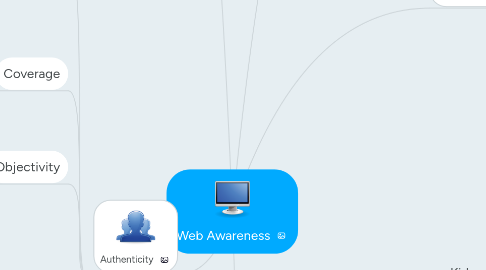
1. Internet Safety
1.1. Sexually Explicty Material
1.1.1. How are children exposed?
1.1.1.1. Accidentally
1.1.1.2. Intentionally
1.1.2. Impacts
1.1.2.1. Shape sexual values, attitudes and behaviours
1.1.2.2. May prematurely sexualize children
1.1.2.3. Increase risk of problematic sexual behaviour
1.1.2.4. Increase Health Risks
1.1.3. What can parents do?
1.1.3.1. Become Aware
1.1.3.2. Filter Content
1.1.3.3. Supervise Children
1.1.3.4. Set Limits
1.2. Cyberbullying
1.2.1. Prevention
1.2.1.1. Use Netiquette
1.2.1.2. Don't Share Personal Information
1.2.1.3. Create Strong Passwords
1.2.1.3.1. Do NOT share
1.2.2. Are you a victim?
1.2.2.1. Inform an Adult/Local Police
1.2.2.2. Don't Reply to Unknown Messages
1.2.2.3. Don't Erase Messages
1.3. Web Awareness for Teachers
1.3.1. Educational Games
1.3.2. understand the dangers that are involved with the internet
1.3.2.1. Public vs. Private Sites
2. Authenticity
2.1. Authority
2.1.1. Does this page have an author?
2.1.1.1. Contact Information
2.1.1.2. Do they have expertise?
2.1.2. Ask
2.1.2.1. Ask a Librarian
2.1.2.2. Use WhoIs
2.1.3. Is the Publisher reliable?
2.2. Coverage
2.2.1. Relevant Information
2.2.1.1. Is this useful to me?
2.2.2. In-depth Information
2.3. Objectivity
2.3.1. Minimal Bias
2.3.2. Facts Vs. Opinion
2.3.3. Free of Advertisements
2.4. Accuracy
2.4.1. Reliable and Error-free Information
2.4.1.1. Free of spelling mistakes?
2.4.1.2. Confirm information
2.4.2. Frequently Updated
2.4.3. Is there an editor?
2.4.3.1. Websites hardly ever have "fact checkers"
2.5. Currency
2.5.1. Current Links
2.5.2. Up to Date Information
2.5.2.1. Date may be seen in footer of the page
2.6. True or False?
2.6.1. Use multiple sources to make sure information is correct
2.6.2. Be aware of strong opinions that may occur over the internet
2.6.3. Use the 5 criteria of authenticity
3. Privacy
3.1. Issues to Consider
3.1.1. Audience
3.1.1.1. Anyone can see what you publish
3.1.2. Anonymity
3.1.2.1. Everything can be traced back to original author
3.1.3. Permanence
3.1.3.1. Whatever is published may be able to be seen for years to come.
3.1.3.1.1. Benefit vs. Problem
3.1.4. Copyright
3.1.4.1. AGAINST THE LAW
3.1.5. Free Speech
3.1.5.1. No Insults
3.1.5.2. Cautious of other's
3.2. Very Important with Social Media
3.2.1. No Pictures
3.2.2. Log out of Accounts
3.2.3. Understand the Privacy Settings of all sites
4. Copyright
4.1. Importance of citations
4.1.1. Teachers need to model appropriate citations to students
4.1.2. Images, Articles, Videos, etc.
4.2. Fair Use Property
4.3. The correct use of Copying and Pasting ( AVOID COPYRIGHT)
5. Marketing
5.1. Targets
5.1.1. Kids
5.1.1.1. Use of Celebrities
5.1.1.2. Use of Similar Age Kids
5.1.2. Schools
5.1.2.1. Sponsorship
5.1.2.1.1. Food
5.1.2.1.2. School Events
5.2. Advertisements
5.2.1. Banner Ads
5.2.2. In- app Advertisements
5.2.3. Viral Ads
5.2.4. Behavioural Targeting
5.2.4.1. Recent Search History
5.2.4.2. Location
5.2.4.3. Personal Interests
